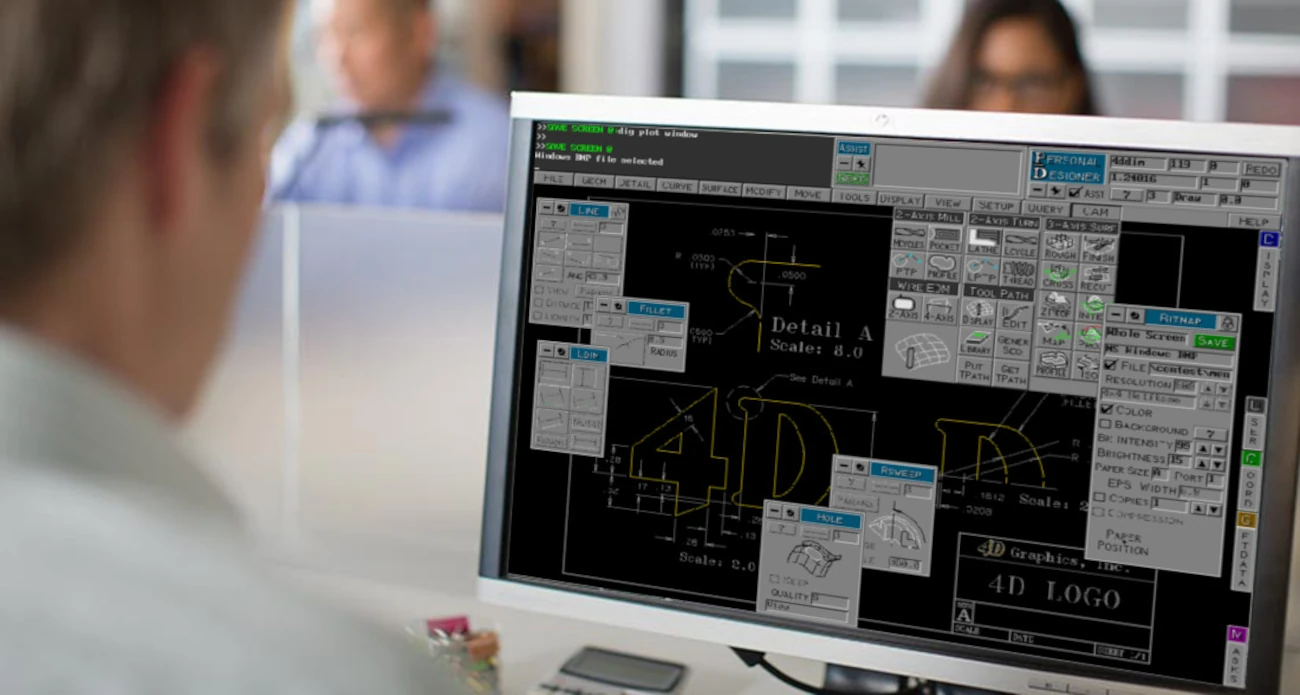In an industrial world where the sustainability of technical data represents a major strategic issue, companies face a significant challenge: how to access valuable design archives created with Personal Designer, a flagship software from the 80s-90s, now obsolete? These DRW files often contain decades of industrial know-how and intellectual property. According to a recent study, more than 67% of industrial companies still possess critical archives in obsolete formats, inaccessible with modern tools.
The gradual disappearance of technical skills and compatible infrastructure jeopardizes this invaluable technical heritage. However, a solution exists to effectively visualize and migrate these archives without data loss.
Table of contents
- The technical legacy of Personal Designer
- Technical issues with Personal Designer archives
- Fundamental needs in CAD archive visualization
- DraftView: visualization solution for Personal Designer
- Migration and conversion of archives with DraftView
- Strategic benefits of archive migration
- Implementation and deployment of the solution
The technical legacy of Personal Designer
Developed in the 1980s by Computervision, Personal Designer quickly established itself as an essential reference in the field of 2D computer-aided design. At a time when CAD represented a revolution for design offices, this software accompanied the digital transformation of many industrial sectors.
Personal Designer marked an entire generation of engineers and technical drafters with its power and precision. Its proprietary .DRW format became a de facto standard in several industries such as aerospace, automotive, and defense.
Technical characteristics that made it successful:
- Advanced user interface for its time
- Exceptional precision in 2D design
- Sophisticated management of layers and attributes
- Custom font system
- Comprehensive measurement and annotation capabilities
At its peak in the 1990s, Personal Designer equipped more than 30% of R&D departments in heavy industry. This widespread adoption explains why millions of technical files remain stored in this proprietary format today, representing a considerable heritage of industrial intellectual property.
Technical issues with Personal Designer archives
The value of Personal Designer archives remains intact, but their accessibility drastically decreases year after year. This situation creates major technical challenges for companies.
Incompatibility with modern systems
Personal Designer was designed to run on older versions of Windows, particularly Windows 95, 98, and XP. With current 64-bit operating systems, running this software becomes problematic, if not impossible without resorting to complex and costly virtualization solutions.
| Operating System | Compatibility | Workarounds |
|---|---|---|
| Windows 95/98/XP | Native | Obsolete physical machines |
| Windows 7 | Limited | Compatibility mode |
| Windows 10/11 | None | Complex virtualization |
Loss of skills and know-how
The retirement of staff proficient with Personal Designer creates a skills deficit. According to a recent industrial survey, 78% of companies that used this software no longer have experts capable of using it effectively.
Hidden maintenance costs
Maintaining obsolete infrastructures solely to access these archives represents a significant and growing cost:
- Maintenance of old computers and operating systems
- Increased IT security risks
- Considerable technical time for occasional data extraction
- Impossibility of integration with modern digital workflows
Faced with these challenges, companies find themselves in a critical situation: continue to bear increasing costs to maintain access to these archives, or risk permanently losing access to this technical heritage.
Fundamental needs in CAD archive visualization
To effectively preserve the value of Personal Designer archives, companies must precisely identify their needs in terms of visualization and exploitation of historical technical data.
Sustainable accessibility to technical data
Access to technical archives should not depend on obsolete systems or disappearing skills. Modern solutions must guarantee sustainable access to this data, regardless of future technological developments.
Fidelity to original models
Technical precision constitutes the very essence of these archives. Any visualization solution must guarantee perfect reproduction of the following elements:
- Exact geometry of 2D elements
- Respect for technical dimensions and annotations
- Preservation of coordinate systems
- Faithful rendering of graphic attributes (line types, thicknesses, etc.)
- Support for Personal Designer-specific custom fonts
Essential features for exploitation
Beyond simple visualization, technical professionals expect features that allow concrete exploitation of these archives:
| Feature | Technical utility |
|---|---|
| Precise measurement | Verification of dimensions and manufacturing |
| Advanced zoom and navigation | Analysis of technical details |
| Layer management | Organization of visual information |
| Scale printing | Paper technical documentation |
| Export to modern formats | Integration with current workflows |
Integration into the modern technical ecosystem
The ideal solution must allow the exploitation of this data in companies' current digital environment, facilitating sharing and collaboration on these historical resources.
DraftView: visualization solution for Personal Designer
Faced with the technical challenges posed by the obsolescence of Personal Designer, DraftView emerges as a solution specifically designed to meet the needs for visualization and migration of archives in DRW format.
Native visualization of Personal Designer files
Unlike generic CAD viewers, DraftView has been developed with specific support for the DRW format, ensuring perfect fidelity to original files:
- Direct reading of DRW files without prior conversion
- Complete support for 2D geometric entities
- Correct display of Personal Designer custom fonts
- Preservation of coordinate systems and scales
- Management of multiple views (MViews) as in the original environment
Intuitive and powerful interface
DraftView offers a modern and accessible interface, allowing even users unfamiliar with Personal Designer to effectively exploit technical archives:
| Feature | Technical advantage |
|---|---|
| Smooth and fast navigation | Efficient exploration of complex drawings |
| Layer control | Selective visualization of information |
| Precise measurement tools | Verification of critical dimensions |
| Text search | Quick location of specific elements |
Extended system compatibility
Unlike Personal Designer, DraftView works perfectly on modern operating systems:
- Compatibility with Windows 10 and 11 (32 and 64 bit)
- Modest hardware requirements allowing deployment on standard workstations
- Simple installation not requiring advanced administrator rights
This extended compatibility frees companies from the need to maintain obsolete systems solely for accessing Personal Designer archives.
Migration and conversion of archives with DraftView
Beyond simple visualization, DraftView offers powerful features to migrate Personal Designer archives to modern and universally accessible formats.
Conversion to standard formats
DraftView's conversion capabilities allow transforming DRW files into open and standardized formats:
- Export to DXF/DWG for interoperability with current CAD solutions
- Generation of vector PDFs for archiving and sharing
- Export options adapted to users' specific needs
Efficient batch processing
For organizations with thousands of DRW files, manual conversion would be prohibitive in terms of time and resources. DraftView offers optimized batch processing features:
| Capability | Operational advantage |
|---|---|
| Simultaneous conversion of multiple files | Dramatic reduction in migration time |
| Scheduling options | Execution during off-peak hours |
| Detailed operation log | Complete traceability of the migration process |
| Intelligent error management | Increased reliability of the overall process |
Preservation of data integrity
The migration of technical archives requires scrupulous preservation of the integrity of the original data. DraftView guarantees this integrity through:
- Precise conservation of geometry and metadata
- Intelligent mapping of specific fonts to modern alternatives
- Preservation of layer structures and attributes
- Maintenance of references and associations between technical elements
This fidelity to the original data ensures that the technical value of the archives is fully preserved after conversion.
Strategic benefits of archive migration
The migration of Personal Designer archives to modern formats with DraftView offers substantial advantages that far exceed mere technical accessibility.
Securing intellectual heritage
Technical drawings constitute valuable intellectual capital for industrial companies. Their preservation represents a guarantee against the loss of technical know-how:
- Protection against technological obsolescence
- Independence from disappearing specific skills
- Sustainable conservation of historical innovations and technical solutions
- Preservation of the company's industrial memory
Significant reduction in infrastructure costs
Eliminating obsolete systems dedicated to Personal Designer generates substantial savings:
| Eliminated cost item | Financial impact |
|---|---|
| Maintenance of obsolete equipment | Direct savings on IT budget |
| Virtualization licenses | Reduction in software costs |
| Physical storage space | Optimization of real estate resources |
| Specialized technical support | Decrease in external expenses |
Integration into modern workflows
The availability of archives in standard formats allows their smooth integration into current design processes:
- Reuse of proven designs in new projects
- Facilitated sharing between teams and partners
- Incorporation into modern document management systems
- Use as reference in quality and certification processes
Valorization of technical capital
Migration makes it possible to exploit this technical heritage to create new business opportunities and accelerate innovation:
- Analysis of historical designs for continuous improvement
- Rapid supply of spare parts for older products
- Development of new product generations based on accumulated experience
- Facilitated compliance with legal obligations for technical archiving
Implementation and deployment of the solution
Adopting DraftView for managing Personal Designer archives can be done in different ways, adapted to the specific needs of each organization.
Flexible deployment options
DraftView offers several installation modes to adapt to companies' infrastructures and IT policies:
- Individual workstation installation for occasional needs
- Network deployment for shared access to technical archives
- Server configuration for large archive collections
- Integration options with existing EDM systems
Structured migration process
To ensure migration success, a methodical approach is recommended:
| Stage | Activities |
|---|---|
| Initial assessment | Archive inventory, identification of priorities |
| Pilot project | Test on a representative sample |
| Progressive migration | Processing by coherent collections |
| Quality validation | Sampling verification of converted files |
| Final integration | Incorporation into documentary systems |
Key success factors
The experience of numerous Personal Designer archive migrations highlights several determining factors for project success:
- Involvement of end users from the early stages
- Training adapted to different user profiles
- Clear documentation of search and usage processes
- Responsive technical support during the transition phase
- Effective communication on the advantages of the new system
Solution sustainability
DraftView benefits from continuous development ensuring its compatibility with future technological evolutions:
- Regular updates for compatibility with new operating systems
- Evolution of export capabilities to emerging formats
- Technical support maintained over the long term
- Active community of users contributing to continuous improvement
This sustainability ensures companies that their investment in migrating Personal Designer archives will retain its value over time.
Conclusion: sustainably valorizing your technical heritage
The preservation and exploitation of Personal Designer archives represent a strategic issue for many industrial organizations. Faced with the planned obsolescence of the DRW format and the infrastructures that support it, migration to modern formats is no longer an option but a necessity.
DraftView offers a complete response to this problem, combining technical fidelity, performance, and ease of use. By combining native visualization and precise conversion, this solution allows unlocking the value locked in historical archives while eliminating obsolete technological constraints.
The experience of many companies that have already made this transition demonstrates that the benefits far exceed mere technical access to data. Reduced infrastructure costs, integration with modern processes, and valorization of intellectual capital constitute tangible advantages that fully justify the investment.
In an industrial context where resource optimization and know-how capitalization represent major competitive assets, the intelligent migration of Personal Designer archives with DraftView stands as a strategic approach oriented toward the future, while preserving the technical heritage of the past.



